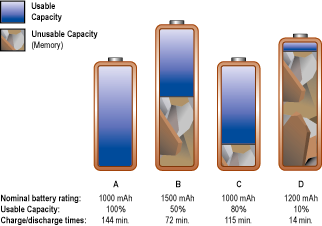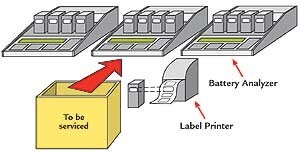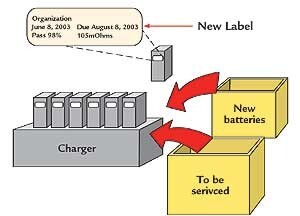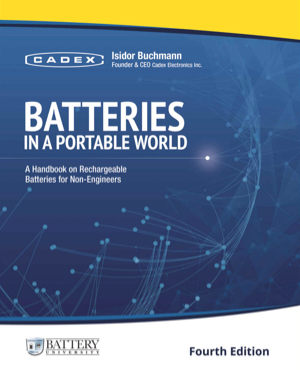When charging a battery, the charger's ready light will eventually illuminate, indicating that the battery is fully charged. The user assumes that the battery has reached its full potential and the battery is taken in confidence.
The 'green light' lies
The 'green light' does not guarantee sufficient battery capacity or assure good state-of-health (SoH). "Ready" only indicates that the battery is full to whatever capacity that was available to fill.
The rechargeable battery is a corrosive device that gradually loses the ability to hold a charge. Lack of periodic maintenance on nickel-based batteries hastens the capacity loss through crystalline formation, also known as memory. Lead and lithium-based batteries have other age related degradations. The capacity loss becomes apparent after one year of service. Some batteries deteriorate faster than others.
Battery users are often unaware that their fleet batteries may barely last a day with minimal energy reserve to spare. Weak batteries can hide comfortably because little demand is placed on them in an ordinary day. The situation changes when full performance is required during an emergency. A collapse of portable communications is common and such breakdowns are often caused by poor battery performance.
 | Figure 1: The green 'ready' light on a charger does not provide performance verification. It simply reveals that the battery is fully charged. |
Weak batteries charge quicker and remain on 'ready' longer than strong ones. Bad batteries tend to gravitate to the top and become a target for the unsuspecting user. In an emergency situation when quick charging action is required, the batteries that are on 'ready' may be deadwood. In the meantime, the good packs are still charging because they have more capacity to fill.
Large performance variations between the batteries will occur over time if the fleet batteries are not checked and maintained on regular schedule. Figure 2 illustrates four batteries of different sizes and state-of-health conditions. When observing the usable and unusable part of a battery, one can see that the larger packs do not necessarily carry more energy. Memory ridden batteries B and D retain less energy than the smaller battery A. Carrying larger batteries or switching to energy-dense chemistries does not improve system reliability if weak packs are left in the fleet.
 | Figure 2: Comparison of charge and discharge times. Carrying larger batteries or switching to high energy-dense chemistries does not improve system reliability if weak packs are left in the fleet. |
A weak battery can be compared to a fuel tank of a car that has been crushed. Refueling this tank is quick because it holds only a small amount of fuel. Like the green light on a charger, the fuel gauge will show full when the tank has been filled and everything looks normal to the driver. However, the distance traveled before refueling will be short.
Batteries do not offer a fuel gauge to check the remaining energy and periodic battery maintenance is required. The benefit of such an exercise is three-fold: it identifies and eliminates non-performers, it increases battery reliability, and it prolongs the of life nickel-based batteries. Weak batteries affected by memory can often be restored to full service with battery analyzers featuring the recondition program.
Battery maintenance made simple
A simple, self-governing maintenance system for fleet batteries is illustrated in Figures 3, 4 and 5. The time required maintaining a large battery fleet should take less than 30 minutes per day. The analyzer used should be able to produce battery stick-on labels and feature a battery recondition program. A properly run battery maintenance program pays back in less than one year on prolonging battery life alone, not to mention the benefit of improved system reliability.
 | Figure 3: Sorting batteries for servicing. Each time a battery is taken from the charger, the user checks the service date on the label attached to the battery. If expired, the battery is placed in the 'To be serviced' box. |
 | Figure 4: Servicing expired batteries. The batteries are re-energized with Cadex battery analyzers and re-certified by attaching a new label with dates and capacity reading. |
 | Figure 5: Returning batteries to circulation. The restored batteries go back into circulation; those that failed are replaced with new ones. Battery maintenance assures that all packs perform at the required capacity level. |
Rechargeable batteries do not die suddenly but gradually get weaker over time. Implementing regular battery maintenance greatly reduces unexpected downtime caused by weak batteries. Manufacturers of portable equipment stress the importance of regular battery testing and endorse the use of battery analyzers.

Comments
Looking for comments from the previous website?
Comments from the previous website are not compatible with our new commenting system but we have preserved them so our users can still reference and make use the information in them.
